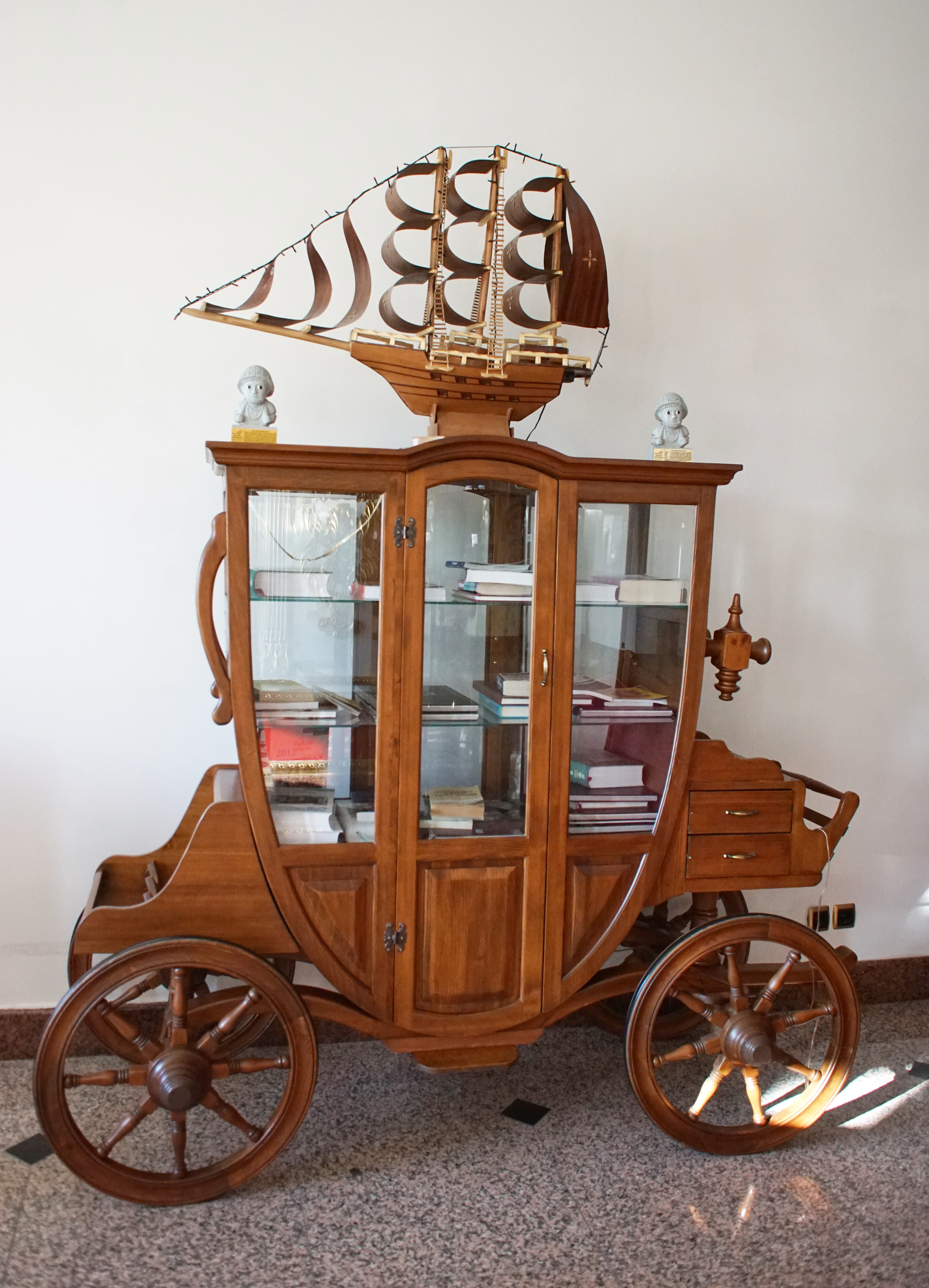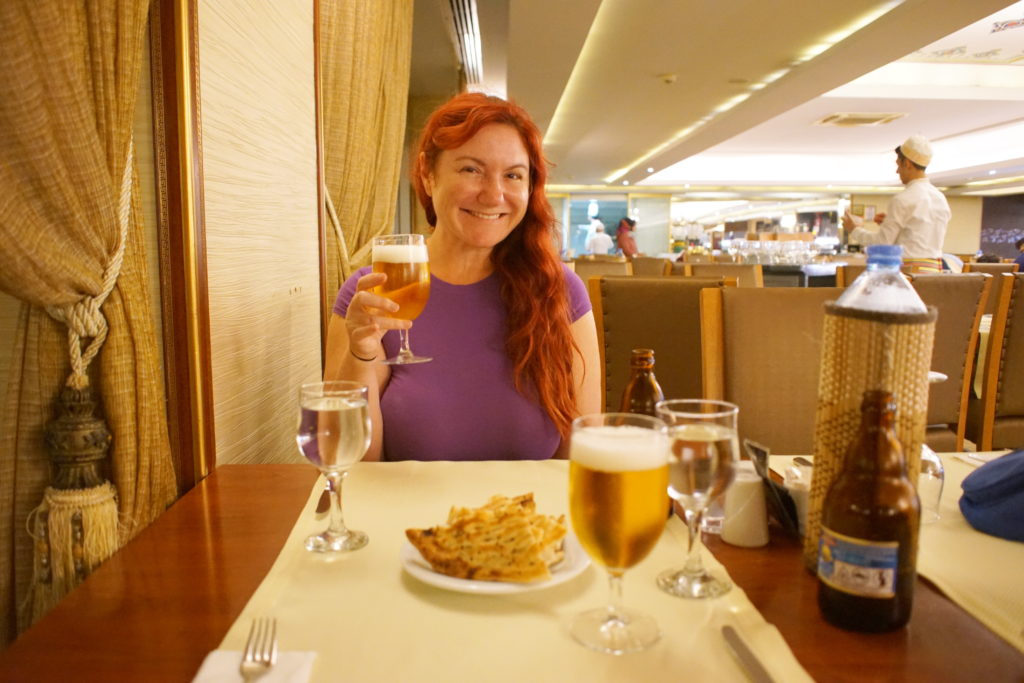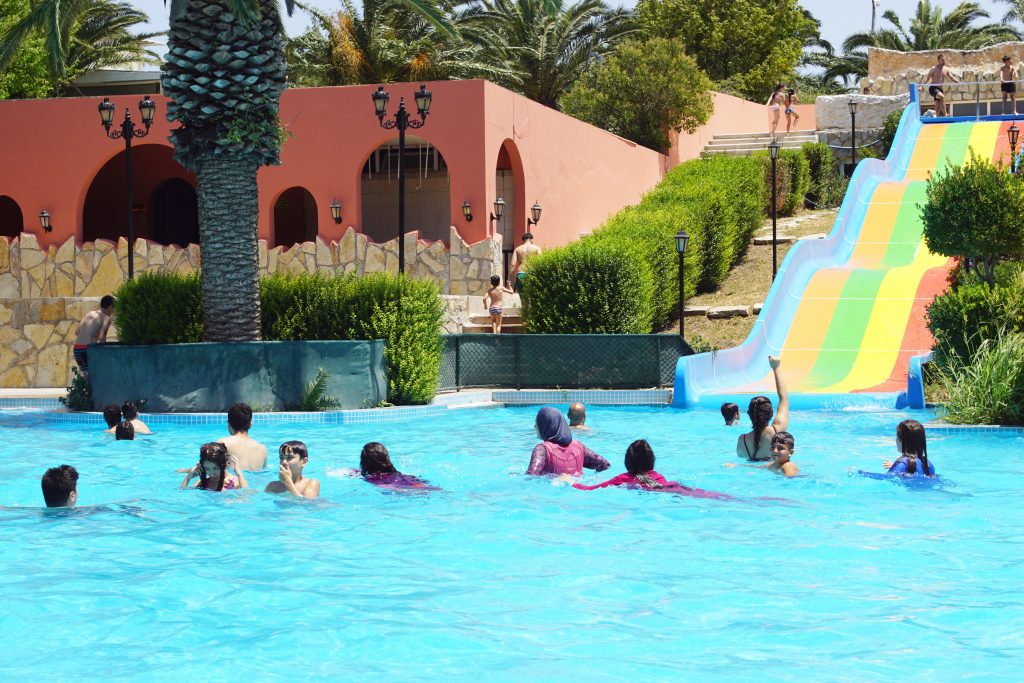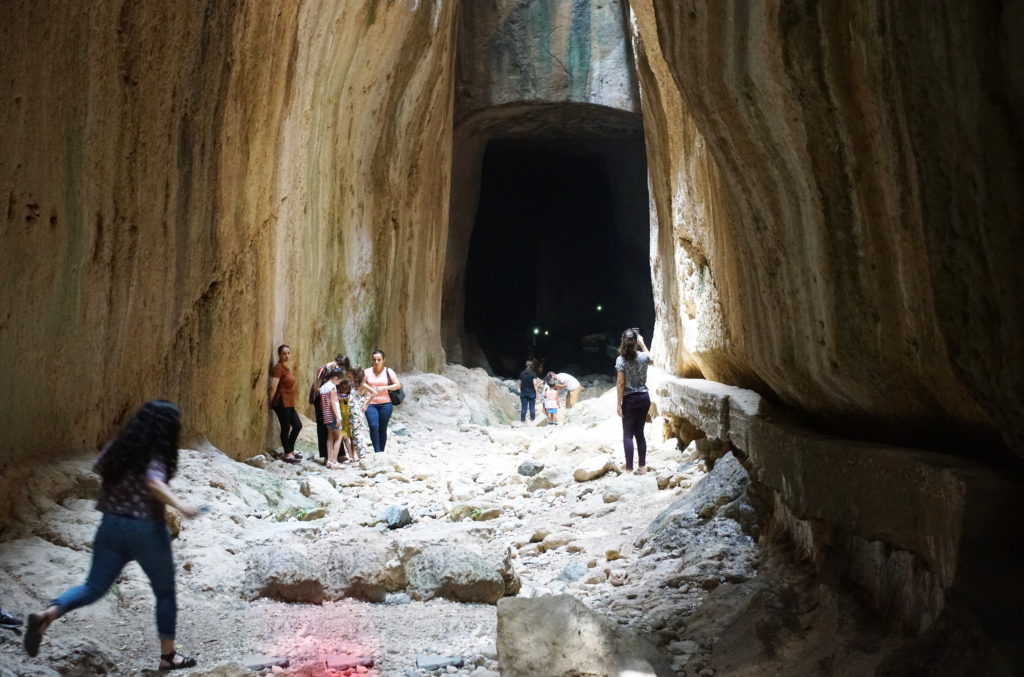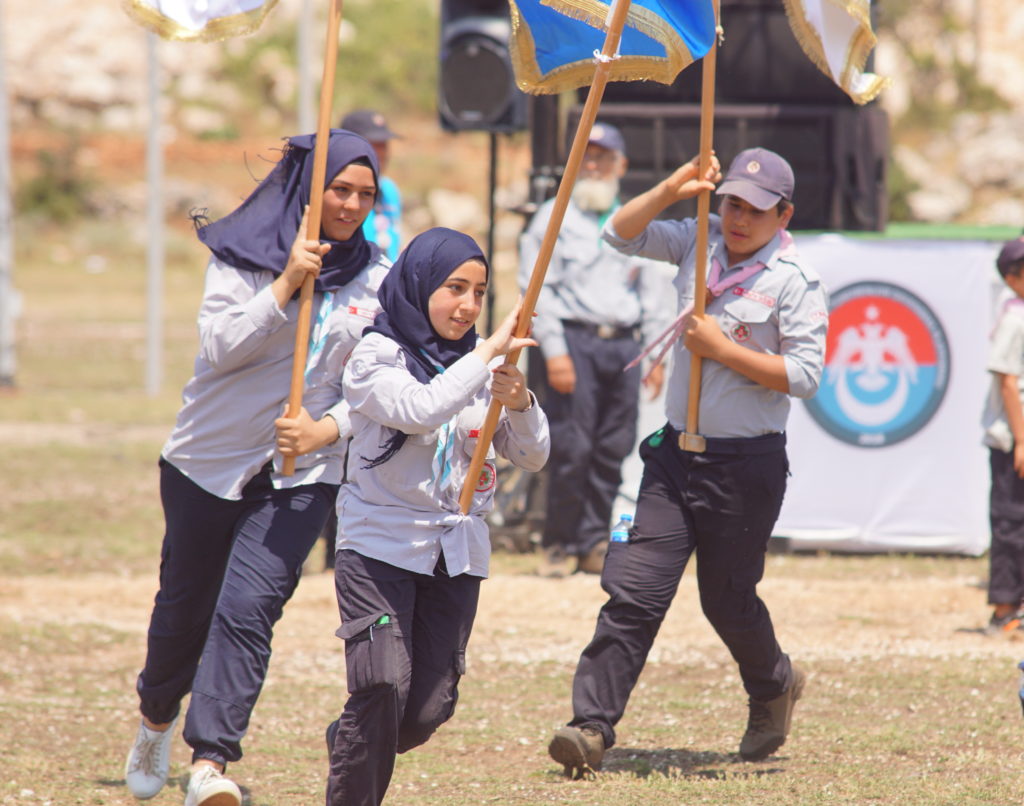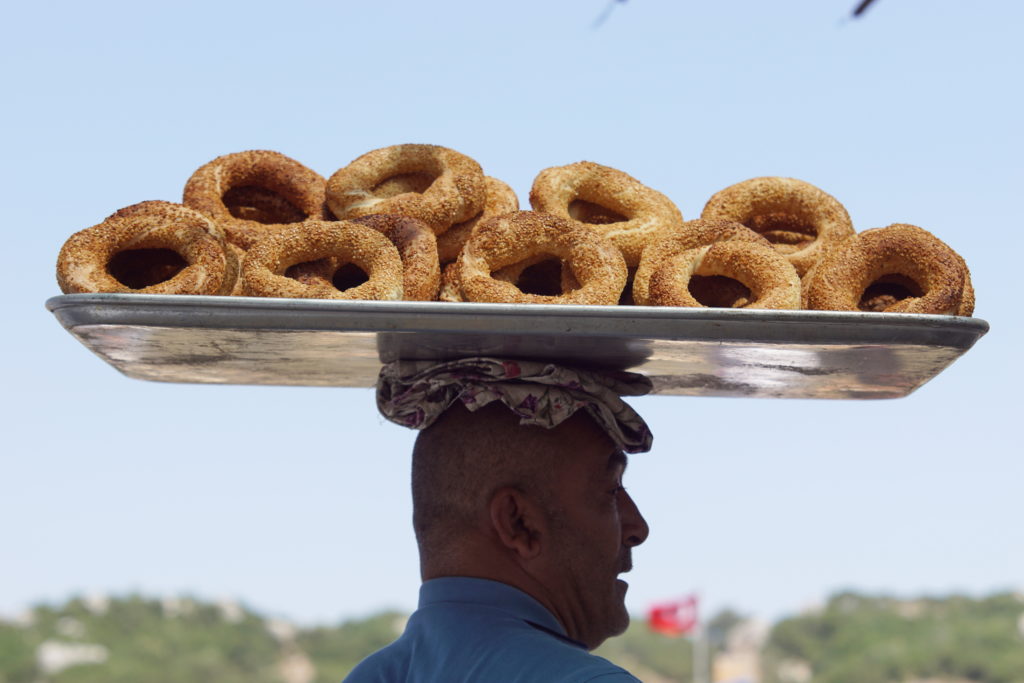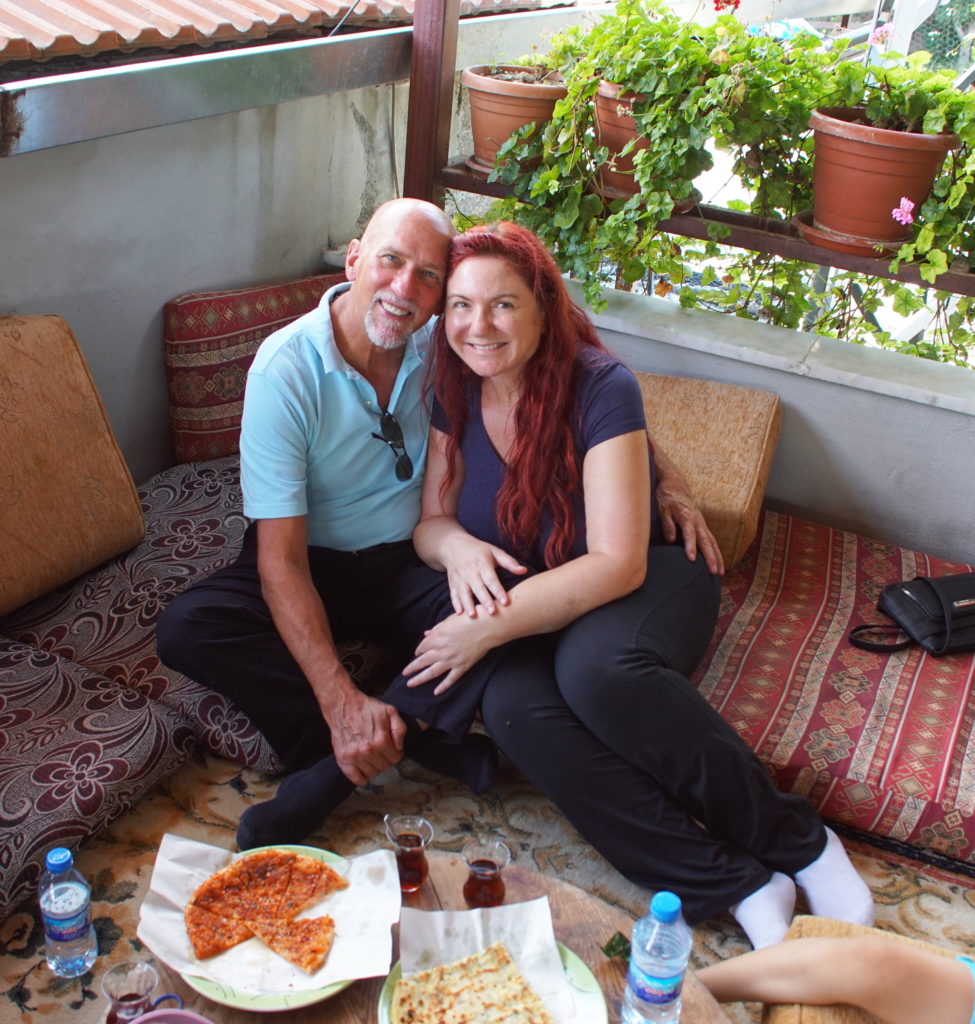We are in Reyhanlı, Turkey, specifically to have dinner with the relatives of our San Diego next door neighbor (who grew up in Reyhanlı). There are other fun places we will visit in the area, but we are starting with Reyhanlı.
First of all, it’s Reyhanlı, not Reyhanli. Notice the final character: it is a dotless lowercase I. Secondly, the Internet thinks Reyhanlı is all about terrorists, but the Internet, surprisingly, is in error.
Okay, where the heck is Reyhanlı? It’s in Turkey very near the Mediterranean Sea and about 5 kilometers from Syria, on the main road that runs between İskenderun, Turkey and Aleppo, Syria. Does that help? Okay, maybe a map would be better.
See the tiny red dot in the middle? That’s us!
The Feast of Reyhanlı
We arrive at the flat and are greeted by more people than we can remember. We are a bit nervous, hoping that we don’t say or do anything to embarrass our hosts, and we expect they have the same concerns. We are led past the kitchen and other rooms with closed doors until we arrive in the (we suppose) living room. We sit on a comfortable couch and watch our hosts curiously as they watch us in the same way. Fortunately, many of people in the house speak English, so conversation is possible. 🙂
We ask questions about them and they ask questions about us. There are enough people who speak both Turkish and English that no one is left out of the conversation.
One of the first questions our hosts asks us is this: Do you want to eat at the table, or on the floor in traditional Turkish style? Well, better the adventure you’ve never tried, right? The women quickly lay down a plastic “tablecloth” over the rug, then serve the food in front of us, family-style.
This photograph does not do justice to the delicious flavors wafting up from the food, nor the sense of excitement because we are about to indulge in an authentic Turkish feast in Turkey with Turks. The food is hot and delicious.
To keep a sense of cultural influences, we, as guests, are seated in a place of our choosing. All the plates, utensils, food, and everything else are brought out and set by the women of the house. The men continue the lively conversations with their guests.
That’s not to say the women are subservient; rather, there are set responsibilities, understood by all. You can see here the smiling faces.
We admit that this sitting position was not entirely comfortable. It’s not so much sitting cross-legged, but rather leaning over those crossed legs to politely eat. You can see that a few people were able to position their legs differently, but we were not. Still, it’s a small price to pay for the experience.
What we quickly learn is that, if we finish any particular food, such as the chicken, someone puts another piece of chicken on our plate. Despite our “eat everything on your plate” brainwashing, we are forced to leave a full plate of food to indicate we had eaten enough. (We want to eat more but our friend had taken us out for a “light snack” just a couple of hours earlier so we weren’t very hungry.)
At the end of dinner, the young women offer us Turkish coffee, and tea with cookies. I try Turkish coffee which is quite strong so I only finish about half of the cup. One of the nieces then asks if we want tea and, when I said “No, thank you”, she has a look of concern and bites her bottom lip. Uh oh, I think I made a cultural faux-pas! But, I’m well past “full”, and if I don’t say, “No,” the food and drink won’t stop!
Okay, that’s not a criticism. Rather, it’s an acknowledgement that our cultural influences do not always align with others, and we have to accept that everyone is trying their best to be polite and generous.
A few notes.
The fellow in the lower right of the above photograph is the family Patriarch. He has 3 concurrent wives, 15 children, and 76 grandchildren (so each grandchild has 75 cousins.) For a good part of our visit, he channel-surfed a handful of Turkish TV stations. When he left the room (we think it was to go on the patio to smoke), one of the women immediately turned off the TV—then quickly asked the male guests if they wanted to continue watching.
The girl in the orange chair (above) spoke with us after dinner and was very concerned that we were childfree. She said, “I won’t ask any more questions… but… I’m worried for you”. I don’t know if she was worried about my health, or of who will take care of me when I’m old, or ?? But it was a sweet gesture. In Turkey, it seemed rare to see any woman walking around without a baby and/or child in hand.
This gives a good perspective into the interrelationships of Middle Eastern people. In Turkey, if you lose your job, one of your relatives will find one for you. There is always a family member to watch your house, your business, or your children. The idea of having a family of “just the two of us” doesn’t seem to exist in this culture.
Our neighbor spent a full month in Turkey with his wife and four daughters. He bought a used van so he could carry everyone (including us for a few days). When he left, he simply gave the van to a relative, knowing it would be cared for and available next time he visited.
Okay, let’s see what else there is to see in this great land!
Ottoman Palace
While relaxing in Reyhanlı, we are staying at the Güngör Ottoman Palace, a hotel “designed and constructed a way befitting the greatness of title,” just outside the city of Antakya. The hotel is, indeed, splendid.

The entrance to the Ottoman Palace, “registered in the ministry of tourism is the only five-star hotel.”
Note that the two fellows on either side of the doorway are not real. Well, they are “real”, just not real people.
The lobby is designed to impress, and it does. All the furniture and fixtures are in keeping with the Ottoman Empire theme, and the hotel has a quiet elegance to it.
The lobby is spacious and seems to always be empty. We aren’t sure why a hotel was built on the outskirts of a city that seems to have no particular tourist draw, but what do we know?
The hotel has many pieces of art, including this one showing Bayezid I, looking at us as if to say, “Well? I’m waiting!!” Notice the fancy turban; we look, but do not find any to purchase. Man, that would have been cool! 😎
The hotel has many other works of art. Here are a few for you to enjoy.
Enough of the lobby. Check out the bed in our room!
We don’t know what we did to deserve this, but we are certain impressed with the care—and fun—the staff puts into helping us enjoy our stay!
The hotel has many amenities, including a game room, thermal tubs, massages, a very nice restaurant, and both indoor and outdoor swimming pools.
As usual, we have the restaurant almost entirely to ourselves. Well, if you can’t travel in shoulder season, at least travel off the beaten path.
We do not have time to see any seven-dimensional productions and, frankly, it frightens us just a little.
There is a roundabout near the hotel with a sculpture that’s also a fountain. The sculpture is, well, unusual. Okay, it’s ugly. There, I said it.
Have you ever seen so many exclamation points? This must be important!!! Let’s use Google Translate.
No wasted seedlings!
All inclusive except Waste!
No waste, no treats!
As a result, respect for the environment is respect for people.
Respect for the environment is the duty and responsibility of the person to himself!
However, Google Translate is somewhat imperfect, as you can see below. So, we just have to assume that their intentions are good.
Yes, there seems to be somewhat different translations based on punctuation. Feel free to try it yourself. Just use different punctuation!!!
İsraf olmasın fidan olsun!
No, we did not forget the most important part of the Güngör Ottoman Palace: waterslides!
Notice the lack of lifeguards or any other adult controlling access to the slides. The stairs leading to the top of the slide are wet and uneven, and there are no handrails. Turkey has a very relaxed attitude toward such things. If you hurt yourself in Turkey, you do not sue anyone for damages, even if the other party was negligent. Rather, you are expected to watch out for yourself and make reasonable decisions. Thus, each slider waits until the previous slider is safely out of the way before launching.
Sensible, isn’t it?
On the other hand, people smoke and drink from glass containers poolside, so that’s not cool.
Besides the slide pool, there is a second, much larger outdoor pool that is deeper. For reasons we don’t know, there are no diving boards. Maybe Turks can’t dive?
Except for standing up, I think there are no restrictions on sliding. At least, there are none posted. Well, none in English…
Sometimes, friends and family slide down in a cluster. Well, why not?
The wide slide allows us sliders to spin, curl, tuck, change directions, and do just about anything we want. Sweet.
Although many sliders wear skimpy swimming attire, other sliders prefer to keep themselves covered but for their hands and face. I wonder if they go down the slide faster…
Nope. This restaurant, like many others in this area, is built in a river bed of a cool spring. As you can see from the photograph, not everyone finds enjoyment in soaking their tootsies in cool water, but we do. 😎
The food is tasty and, of course, so is the beer, and if you need to spit, well, don’t. That’s nasty no matter where you are!
The sign with the red lettering contains a quotation from Can Yücel’s poem, Farkında Olmalı İnsan. You can put the phrase into Google Translate and find all kinds of interesting meanings depending on punctuation and line breaks….but, I suppose a poet would understand that poems are meant to be interpreted by the listener/reader.
Titus Tunnel
Our host takes us to visit the UNESCO World Heritage Site Vespasianus Titus Tunnel.
The Turks thoughtfully provide a translation for “Titus Tüneli” in case of confusion.
We have been walking for a bit, and still no tunnel. Still, it’s a beautiful day, so we are happy.
We finally arrive at the actual tunnel, and it’s pretty cool. The lights in the darkness are other visitors using flashlights (probably phones) to better see the ground.
According to the Internet: The height of this 64 meter long channel reaches up to 25-30 meters and becomes narrower close to the surface, because of former karst solution channels encountered along its alignment.
This photograph shows the size of the tunnel. Elvis would have said, “That sucker’s huge!”
Romans were consummate engineers, and this bridge will probably be around in 2,000 more years. Although, without guard rails, I don’t think it will ever be OSHA compliant.
The Tree of Moses on Defne Road
According to Jewish biblical stories, Moses was a poor child who was put in a reed basket, discovered by Egyptian royalty, and raised as one of them (see also Sargon of Akkad‘s birth circumstances). According to Muslim biblical stories, Hizir (also known as al-Khadir, Khader, Khadr, Khedher, Khizr, Khizir, Khyzer, Qeezr, Qhezr, Qhizyer, Qhezar, Khizar, Xızır, Hızır) was a contemporary of Moses.
According to this sign by the municipality of Samandağ, these two fellows went to a mountain together and planted this very tree. For some reason, Hizir’s name was omitted when the tree was named.
They won’t let us look into the tree to see what’s inside. I wonder what they are hiding…
Despite this tree being a miracle tree, folks have taken a saw to it now and again. I wonder if the part that’s cut off is also a miracle tree.
Below the Great Tree is the water of immortality that provided the miraculous growth of Moses’ wooden stick. Sadly, the powers of immortality seem to be species-specific.
Well, as long as we are here, I might as well cool off my feet. And maybe, just maybe, these very feet will be around in 3,500 years!
We see these people talking and point the camera at them and wave and, of course, they grace us with a smile. Life is good in Turkey. 🙂
There was a peaceful vibe throughout this village. Perhaps knowing they live among the Moses Tree helps keep everyone calm, connected, and compassionate.
World Muslim Turkish Festival
The next adventure on our trip is to the World Muslim Turkish Festival, an afternoon filled with speeches, more speeches, and a few more speeches. Fortunately for this magazine, I will not include those. 🙄
The actual name of this festival is Dünya Müslüman Türkleri Buluşma Şöleni, which Google Translate thinks is “World Muslim Turks Meeting Feast”, but let’s stick with World Muslim Turkish Festival.
The festival has a number of skilled horsemen galloping their steed around the grounds. The symbol being made with the gentleman’s right hand is the sign of the wolf, an indication of nationalism.
The riders enter the grounds singly or in groups. Photographers are permitted to be on the grounds while the horses race past.
The lad handles his mount as skillfully as the adults.
This horse is, let’s say, temperamental, and the rider makes three attempts to stand before the horse remains still enough for him to succeed.
Please enjoy this gallery of riders and their horses!
We are treated to a parade of scouts proudly carrying their flags. It’s good for us that the wind is blowing so we can see the flags, but you’ll notice that the flag carriers do not have flag carrying belts, so I expect those flags will get heavy after just a few minutes.
The proud Türkiye İzciler display their marching skills. I had a very similar neckerchief when I was a scout. Never knew what they were for, except perhaps to prepare us for wearing the equally useless tie when we get a fancy job.
This is a bit of a mystery. “Dünya Avşarlar Derneği” seems to mean World Avşarlar Association, and “Avşarlar” seems to reference the Afshar people, but we can’t be sure.
The scouts walk around the ground, then pick up the pace and run past the stage and are gone. We suspect there is substance to this ceremony, but, sadly, that substance is lost on us. Still the procession is pretty cool.
Next, three mats are laid on the ground for two sets of competitors. The goal is to physically force your opponent to join you, while your opponent strives to force you to join him. ¯\_(ツ)_/¯
Note the fierce look of determination and the pronounced farmer’s tan, even down to the feet.
This contest is inconclusive. Rather than allow himself to be pulled to the far side of the barrier, the losing competitor releases his grip and remain safely on his side. The pair begins again, and the process is repeated.
A traditional band entertains us with traditional Muslim Turkish music. At least, we think it’s traditional Muslim Turkish music. How would we know?
What is a World Muslim Turkish Festival without a speech (in English) by a couple of Californians? Yes, we are asked to the stage and are introduced as “The Americans” visiting the festival, and we are handed a microphone. “Thank you for your hospitality and friendship and for making us feel welcome at this festival.” We doubt very many people understand our words but we are sure they understood our message.
We suddenly are locally famous… upon discovering our California heritage, the folks at the festival seek us out to pose with them. Smile and say, “Peynir”.
Well, what else is happening at this festival?
A couple finds an uncrowded spot at the festival to spend some quiet time. I expect a visit from Cupid at any moment.
Festival-goers enjoy an impromptu game of net-less volleyball. And when the ball falls to the ground, they kick it, soccer-style.
The ubiquitous mobile phone allows people across the planet to find diversions, even when attending the World Muslim Turkish Festival.
Nothings says “festival” more than a man wearing a platter of food for sale. It is both a source of income and a shield from the hot Mediterranean sun.
Let’s pay a visit to Zirve Cafe and Piknik Yerleri for a snack!
Zirve Cafe and Piknik Yerleri
The cafe is quiet and comfortable, the perfect place for a picnic.
The cafe does not have a website, but if you go to this exact spot, you will find it. 😛
It is beautiful here, and we are fortunate to have this scenic panorama of the Turkish countryside.
Since this is Turkey, the food is both delicious and plentiful. Yum.
You know are at a traditional restaurant when you can sit on the floor.
Okay, what about nightlife? Not to worry; Turks love nightlife.
Soner Restaurant
We are spending the evening at the Soner Restaurant in Antakya. The restaurant has delicious food and plenty to drink, as you might expect.
But that’s not why we are here.
We are here to see the fabulous singer perform! And, since this is Turkey, you can assume the rules are different. At any time, someone will talk to the singer and she stop mid-verse and engage in a conversation. Then she picks up right where she left off and continues singing.
In fact, when a few of us ladies begin to dance, our singer joins in and shares in the fun.
This is a variation of the “Bro Dance” that guys in America do at wedding when they don’t know how to dance. We are just holding our arms out and lifting our shoulders. Meh.
Here is something you might have missed. The link for the Soner Restaurant is to a Facebook page. If you’ve spent time clicking on links in the online magazine, you might have noticed that there are zero links to Facebook.
Okay, well now there is one Facebook link for the Soner Restaurant. And if you’ll scroll down a bit to July 7, 2019, you’ll find a video of a man and woman dancing tango. 😎
So, we must leave now. Thank you for sharing our adventure with us!!!














